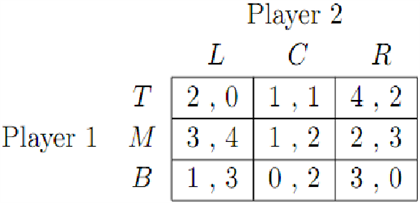Last time we introduced the important concept of Nash Equilibrium in Game Theory. In this blog we will continue to practice solving for pure strategy Nash Equilibrium. All the examples provided will be games of complete information. In addition, I will introduce the concept of iterated elimination of strictly dominated strategies. Let’s begin with the following game:
| 1\2 | C | D |
| A | 1,5 | 2,1 |
| B | 3,3 | 2,2 |
Player 1 has two pure strategies of A and B while Player 2 has two pure strategies of C and D. We will assume that both players make rational choices (look to optimize). Player 1 would rather choose strategy B if Player 2 chooses strategy C since 3 > 1. If Player 2 chooses D, Player 1 will be indifferent between A and B since 2 = 2.
On the other hand, Player 2 will prefer strategy C to D if Player 1 chooses A since 5 > 1. In addition Player 2 will choose strategy C if Player 1 chooses B since 3 > 2. What can be observed from this game so far? Regardless of what Player 1 chooses, Player 2 will always choose strategy C over D due to the higher payoff. Strategy D is an example of a strictly dominated strategy. Rational players do not play strictly dominated strategies. As a result:
| 1\2 | C | |
| A | 1,5 | 2, |
| B | 3,3 | 2, |
becomes
| 1\2 | C |
| A | 1,5 |
| B | 3,3 |
This makes the game a lot easier to solve. Since Player 1 prefers strategy B over A due to the higher payoff and Player 2 will always choose strategy C, the pure strategy Nash Equilibrium for this game is (B,C) for payoff (3,3).
| 1\2 | C |
| A | 1,5 |
| B | 3,3 |
Let’s look at another example with more strategies:
| 1\2 | D | E | F |
| A | 1,0 | 3,2 | 5,3 |
| B | 2,3 | 2,4 | 1,5 |
| C | 3,1 | 1,3 | 3,2 |
First thing to look for is removing any dominated strategies. Do you see any? Let’s break this down to determine if Player 1 has any dominated strategies.
If Player 2 chooses D: C > B > A
If Player 2 chooses E: A > B > C
If Player 2 chooses F: A > B > C
It appears that there are 0 dominated strategies for Player 1. Now let’s take a look to see if there are any dominated strategies for Player 2.
If Player 1 chooses A: F > E > D
If Player 1 chooses B: F > E > D
If Player 1 chooses C: E > F > D
Based on these observations, strategy D is strictly dominated by both strategy E and F. Player 2 will never choose this strategy so it can be eliminated from the game.
| 1\2 | E | F | |
| A | 1, |
3,2 | 5,3 |
| B | 2, |
2,4 | 1,5 |
| C | 3, |
1,3 | 3,2 |
becomes
| 1\2 | E | F |
| A | 3,2 | 5,3 |
| B | 2,4 | 1,5 |
| C | 1,3 | 3,2 |
We can now analyze this game further. Remember earlier when we analyzed whether Player 1 had any dominated strategies? With strategy D eliminated:
If Player 2 chooses E: A > B > C
If Player 2 chooses F: A > C > B
Strategy A dominates both B and C so they both can be eliminated!
| 1\2 | E | F |
| A | 3,2 | 5,3 |
becomes
| 1\2 | E | F |
| A | 3,2 | 5,3 |
So the Nash Equilibrium for this game is (A,F).
| 1\2 | E | F |
| A | 3,2 | 5,3 |
Try to solve for the Nash Equilibrium in the title image above. In my next blog I will go over the solution. I look forward to hearing your feedback.
